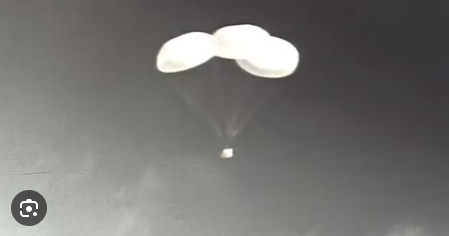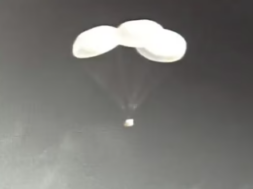
NEW DELHI, Oct 21: The scientists of the Indian Space Research Organisation (ISRO), after a two hours delay and nerve-wracking moments as the engine of TV-D1 failed to ignite initially, on Saturday launched the rocket carrying payloads related to crew safety in Gaganyaan mission with precision from Sriharikota and achieved the goal of Crew Module and Crew Escape separation successfully.
The ISRO chief S. Somanath said, “Gaganyaan’s first Flight Test Vehicle Abort Mission-1 (TV-D1) was successfully accomplished.
It was the first landmark in India’s ambitious space mission. Saturday’s rocket tested the emergency escape system of its crew module, which separated from the thruster and made a soft landing in the Bay of Bengal about 10 minutes after the launch.
This mission was conducted to test the efficiency of the vehicle’s crew escape system, which will be used in case astronauts need to eject in case of an emergency. “We are very happy to announce the success of the mission. The purpose of the mission was to demonstrate the crew escape system. The vehicle went slightly above the speed of sound, before it initiated the crew escape system,” Somanath said from the mission centre.
“The escape system took the crew module away from the vehicle and subsequent operations including the touch-down at the sea have been very well accomplished,” he added.
Test Vehicle D1 mission was scheduled for a lift-off from the first launch pad at 8 am which was revised to 8.45 am. But just 5 seconds before the launch, the countdown stopped. ISRO identified the cause and successfully pulled off the test at 10 am.
The test vehicle mission is the predecessor to the Gaganyaan programme which aims to send humans into space on a Low Earth Orbit of 400kms for three days and bring them safely back to the Earth. India will demonstrate its human spaceflight capabilities in the Gaganyaan mission scheduled to launch in 2024. The country will set up a space station by 2035 and work on a Venus orbiter as well as a Mars lander.
Earlier, just five seconds before the scheduled lift at 8.45 AM, the ISRO had put the mission “on hold.” “The test vehicle lift-off for the Gaganyaan mission could not happen,” ISRO chief S Somanath said minutes after the on-ground computer aborted the lift-off of the rocket.
The countdown had begun as intended and all went as expected till T-6 seconds when the rocket ignition kick-started six seconds before its intended lift-off schedule. Looking at this anomaly, the on-ground computer immediately overrode the lift-off at T-5 seconds and put the mission “on hold.”
“The engine ignition has not happened in the nominal course,” Somanath said in his statement following the incident, adding that “We have to find out what went wrong, will come back soon.” There was a very smooth air lift and automatic launch sequence leading up to the command to lift off, but the engine ignition has not happened in the nominal course due to anomaly,” Mr Somanath said.
Mr Somanath mentioned that the “vehicle is completely safe”. He also said ISRO would “come back soon after analysing what triggered the Automatic Launch Sequence (ALS) holding the vehicle.”
“We will have to reach the vehicle and then look at what has happened now,” Mr Somanath explained, adding that this process “takes some time.” However, ISRO shared an update soon after saying that the launch will happen at 10 am IST. And finally, the vehicle took off at 10 a.m. and the payloads later splashed into the sea as planned, a development that witnessed jubilation.
Addressing the media, ISRO Chairman Somanath said, “I am very happy to announce the successful accomplishment of the TV-D1 mission. The purpose of this mission was to demonstrate the Crew Escape System for the Gaganyaan program through a test vehicle demonstration in which the vehicle went up to a Mach number, which is slightly above the speed of sound, and initiated an abort condition for the Crew Escape System to function.”
“The Crew Escape System took the crew module away from the vehicle, and subsequent operations, including the touch-down at sea, have been very well accomplished. We have confirmation of the data for all of this,” he added. Mr. Somanath congratulated scientists after the successful touchdown of the crew escape module.
On the occasion, mission Director S. Sivakumar said, “This is like a never before attempt. It is like a bouquet of three experiments put together. We have now seen the characteristics of all three systems with what we wanted to test through this experiment or this mission. The test vehicle, the Crew Escape System, the crew module everything, we have perfectly demonstrated in the first attempt. All the systems performed well.” “We had been at penance for the last 3 to 4 years and the D-day was today… We are very happy to be able to do it on the very first attempt,” he added.
(Manas Dasgupta)














